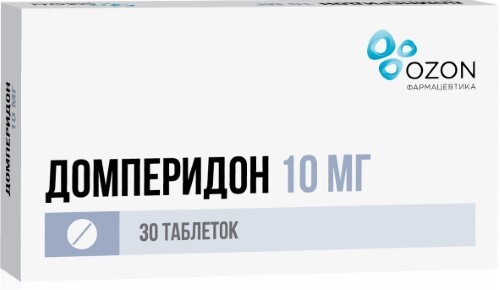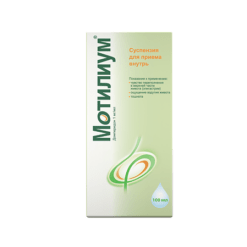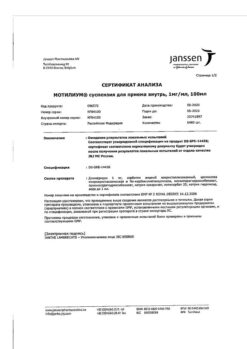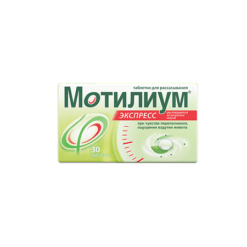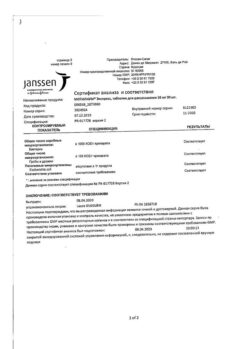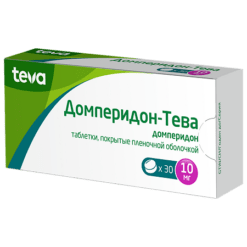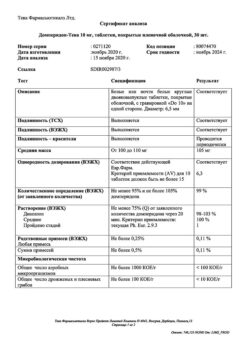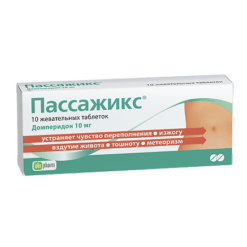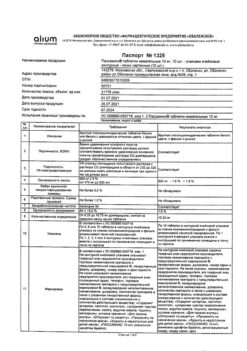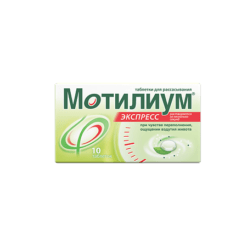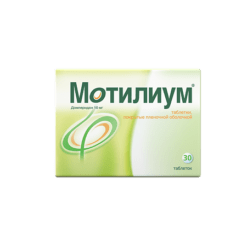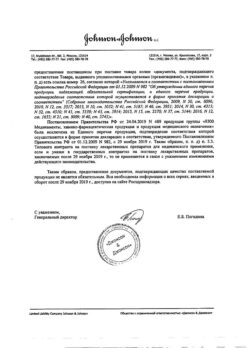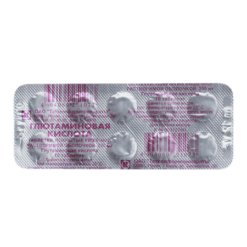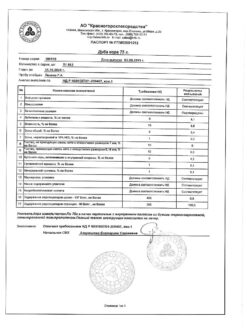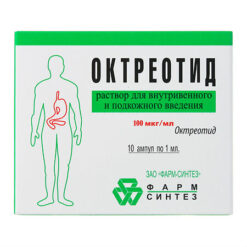No products in the cart.
Domperidone, 10 mg 30 pcs
€9.75 €8.53
Description
Domperidone is a dopamine antagonist with antiemetic properties. However, domperidone poorly penetrates through the blood-brain barrier. Use of domperidone is rarely accompanied by extrapyramidal side effects especially in adults but domperidone stimulates prolactin release from pituitary gland.
Its antiemetic action may be due to a combination of peripheral (gastrokinetic) action and antagonism to dopamine receptors in the chemoreceptor trigger zone. Animal studies and low concentrations of the drug found in the brain suggest a central effect of domperidone on dopamine receptors.
When administered orally, domperidone increases the duration of antral and duodenal contractions accelerates gastric emptying and increases lower esophageal sphincter pressure in healthy people. Domperidone has no effect on gastric secretion.
Pharmacokinetics:
When taken on an empty stomach, domperidone is rapidly absorbed after oral administration, peak plasma concentrations are reached within 30-60 minutes.
The low absolute bioavailability of domperidone when administered orally (approximately 15%) is associated with intense first-pass metabolism in the intestinal wall and liver. Domperidone should be taken 15-30 minutes before meals. Decreased acidity in the stomach leads to impaired absorption of domperidone.
Bioavailability during oral administration is reduced if cimetidine and sodium bicarbonate are taken beforehand. When the drug is taken after meals, it takes longer to reach maximum absorption and the area under the pharmacokinetic curve (AUC) is slightly increased.
In oral administration domperidone does not accumulate and does not induce its own metabolism; the peak plasma level of 21 ng/ml after 90 minutes after 2 weeks of oral dosing of 30 mg daily was almost the same as the level of 18 ng/ml after the first dose.
Domperidone binds 91-93% to plasma proteins.
The distribution studies with the radioactively labeled drug in animals showed significant distribution of the drug in the tissues but low concentrations in the brain. Small amounts of the drug penetrate the placenta in rats.
Domperidone undergoes rapid and intense metabolism by hydroxylation and N-dealkylation. In vitro metabolism studies with diagnostic inhibitors have shown that the CYP3A4 isoenzyme is the major form of cytochrome P450 involved in N-dealkylation of domperidone while the CYP3A4 isoenzymes CYP1A2 and CYP2E1 are involved in aromatic hydroxylation of domperidone.
Elevation through the kidneys and through the intestine is 31% and 66% of the dose when administered orally, respectively. The proportion of the drug excreted unchanged is small (10% – through the intestine and approximately 1% – through the kidneys). Plasma elimination half-life after a single oral administration is 7-9 hours in healthy volunteers but is increased in patients with severe renal impairment.
In such patients (serum creatinine 6 mg/100 ml i.e. > 06 mmol/l) the half-life of domperidone is increased from 74 to 208 hours but plasma concentrations of the drug are lower than in healthy volunteers. A small amount of unchanged drug (about 1%) is excreted by the kidneys.
In patients with liver dysfunction of moderate degree of severity (B score according to Child-Pugh 7-9 points) AUC and Cmax of domperidone were 29 and 15 times higher than in healthy volunteers, respectively. The unbound fraction increased by 25% and the half-life increased from 15 to 23 hours.
In patients with mild hepatic impairment, systemic exposure was lower than in healthy patients. In patients with severe hepatic impairment, pharmacokinetics has not been studied.
Indications
Indications
To relieve symptoms of nausea and vomiting.
Pharmacological effect
Pharmacological effect
Domperidone is a dopamine antagonist with antiemetic properties. However, domperidone does not penetrate the blood-brain barrier well. The use of domperidone is rarely accompanied by extrapyramidal side effects, especially in adults, but domperidone stimulates the release of prolactin from the pituitary gland.
Its antiemetic effect is possibly due to a combination of peripheral (gastrokinetic) action and antagonism of dopamine receptors in the chemoreceptor trigger zone. Animal studies and low concentrations of the drug found in the brain indicate a central effect of domperidone on dopamine receptors.
When administered orally, domperidone increases the duration of antral and duodenal contractions, accelerates gastric emptying and increases sphincter pressure of the lower esophagus in healthy people. Domperidone has no effect on gastric secretion.
Pharmacokinetics:
When taken on an empty stomach, domperidone is rapidly absorbed after oral administration, peak plasma concentrations are achieved within 30-60 minutes.
The low absolute bioavailability of domperidone when taken orally (approximately 15%) is associated with intensive first-pass metabolism in the intestinal wall and liver. Domperidone should be taken 15-30 minutes before meals. Reduced acidity in the stomach leads to impaired absorption of domperidone.
Oral bioavailability is reduced by prior administration of cimetidine and sodium bicarbonate. When taking the drug after a meal, it takes longer to achieve maximum absorption and the area under the pharmacokinetic curve (AUC) increases slightly.
When taken orally, domperidone does not accumulate and does not induce its own metabolism; the peak plasma level of 21 ng/mL at 90 minutes after 2 weeks of oral dosing at a dose of 30 mg per day was almost the same as the level of 18 ng/mL after the first dose.
Domperidone is 91-93% bound to plasma proteins.
Distribution studies with radiolabeled drug in animals showed significant distribution of the drug in tissues but low concentrations in the brain. Small amounts of the drug cross the placenta in rats.
Domperidone undergoes rapid and extensive metabolism by hydroxylation and N-dealkylation. In vitro metabolism studies with diagnostic inhibitors have shown that the CYP3A4 isoenzyme is the main form of cytochrome P450 involved in the N-dealkylation of domperidone, while the CYP3A4 isoenzymes CYP1A2 and CYP2E1 are involved in the aromatic hydroxylation of domperidone.
Excretion through the kidneys and through the intestines is 31% and 66% of the oral dose, respectively. The proportion of the drug excreted unchanged is small (10% through the intestines and approximately 1% through the kidneys). The plasma half-life after a single oral dose is 7-9 hours in healthy volunteers but is increased in patients with severe renal impairment.
In such patients (serum creatinine 6 mg/100 ml i.e. > 06 mmol/l), the half-life of domperidone increases from 74 to 208 hours but plasma concentrations of the drug are lower than in healthy volunteers. A small amount of unchanged drug (about 1%) is excreted by the kidneys.
In patients with moderate hepatic impairment (Child-Pugh B score 7-9 points), the AUC and Cmax of domperidone were 29 and 15 times higher than in healthy volunteers, respectively. The unbound fraction increased by 25% and the half-life increased from 15 to 23 hours.
In patients with mild hepatic impairment, systemic exposure is lower than in healthy patients. Pharmacokinetics have not been studied in patients with severe hepatic impairment.
Special instructions
Special instructions
It is not recommended to use Domperidone to prevent nausea and vomiting after anesthesia.
During long-term drug therapy, patients should be under regular medical supervision.
Domperidone may cause prolongation of the QT interval on the ECG. During post-marketing studies in patients taking domperidone, in rare cases, an increase in the QT interval and the occurrence of torsade de pointes (TdP) were observed. These adverse reactions were observed mainly in patients with risk factors with severe electrolyte disturbances or concomitantly taking drugs that increase the QT interval.
Some studies have shown that the use of domperidone may lead to an increased risk of ventricular arrhythmia or sudden coronary death (especially in patients over 60 years of age or when using a single dose of more than 30 mg, as well as in patients taking concomitant drugs that prolong the QT interval or CYP3A4 inhibitors).
The use of Domperidone and other drugs that can cause prolongation of the QT interval is contraindicated in patients who experience prolongation of cardiac conduction intervals, especially the QT interval in patients with severe electrolyte disturbances (hypo- and hyperkalemia, hypomagnesemia) or in patients with heart diseases such as chronic heart failure.
It has been shown that the presence of electrolyte disturbances in a patient (hypo- and hyperkalemia, hypomagnesemia) and bradycardia may increase the risk of developing arrhythmia. The drug should be discontinued if any symptoms occur that may be associated with cardiac arrhythmias. In this case, you should consult your doctor.
The drug Domperidone enhances the effect of antipsychotics when used simultaneously.
When used simultaneously with dopaminergic receptor agonists (bromocriptine levodopa), Domperidone inhibits the unwanted peripheral effects of the latter, such as indigestion, nausea and vomiting, without affecting their central effects.
It is recommended to take the drug in the minimum effective dose.
Impact on the ability to drive vehicles. Wed and fur.:
Active ingredient
Active ingredient
Domperidone
Composition
Composition
For one tablet:
Active substance: domperidone – 10.00 mg.
Excipients: lactose monohydrate (milk sugar) – 53.10 mg, corn starch – 20.00 mg, microcrystalline cellulose – 10.00 mg, povidone-K25 – 3.00 mg, magnesium stearate – 0.70 mg, sodium lauryl sulfate – 0.20 mg.
Shell composition: hypromellose – 1.15 mg, macrogol-4000 – 0.30 mg, titanium dioxide – 0.55 mg.
Pregnancy
Pregnancy
There is insufficient data on the use of domperidone during pregnancy. The use of the drug during pregnancy is contraindicated.
In women, the concentration of domperidone in breast milk ranges from 10 to 50% of the corresponding plasma concentration and does not exceed 10 ng/ml. Breastfed infants may develop adverse reactions from the cardiovascular system.
In this regard, when using domperidone during breastfeeding, breastfeeding should be discontinued.
Contraindications
Contraindications
– Hypersensitivity to domperidone or any other component of the drug;
– lactose intolerance, lactase deficiency, glucose-galactose malabsorption;
– severe electrolyte disturbances or heart disease such as chronic heart failure;
– children under 12 years of age with body weight less than 35 kg;
– simultaneous use of oral forms of ketoconazole erythromycin or other drugs that increase the QT interval or potent inhibitors of the CYP3A4 isoenzyme such as fluconazole voriconazole clarithromycin amiodarone telithromycin, etc.;
– bleeding from the gastrointestinal tract, mechanical intestinal obstruction, perforation of the stomach or intestines;
– liver failure of moderate and severe severity;
– prolactinoma;
– pregnancy and breastfeeding period.
With caution:
Kidney failure.
Side Effects
Side Effects
According to clinical studies
Adverse reactions observed in ≥ 1% of patients taking domperidone: depression anxiety decreased or lack of libido headache drowsiness akathisia dry mouth diarrhea rash itching galactorrhea gynecomastia pain and tenderness in the mammary glands menstrual irregularities and amenorrhea lactation disorders asthenia.
Adverse reactions observed in <1% of patients taking domperidone: hypersensitivity, urticaria, swelling and discharge from the mammary glands.
According to spontaneous reports of adverse events
The frequency of the following adverse reactions was determined according to the following (World Health Organization classification): very common > 1/10 common > 1/100 to 1/1000 to 1/10,000 to < 1/1000 very rare < 1/10,000 including isolated reports.
Immune system disorders
Very rare: allergic reactions including anaphylaxis, anaphylactic shock, anaphylactic reactions, angioedema.
Gastrointestinal disorders
Rarely: gastrointestinal including transient intestinal spasms; very rarely: diarrhea.
Nervous system disorders
Very rare: extrapyramidal disorders, seizures, increased excitability and irritability, drowsiness, headache.
Disorders of the cardiovascular system
Very rare: prolongation of the QT interval; frequency unknown: ventricular tachyarrhythmia of the “pirouette” type * sudden coronary death *.
Skin and subcutaneous tissue disorders
Very rare: Quincke’s edema, itching of the skin, urticaria.
Renal and urinary tract disorders
Very rare: urinary retention.
Others
Very rare: changes in liver function tests.
Rarely: hyperprolactinemia, galactorrhea, gynecomastia, amenorrhea.
*Some epidemiological studies have shown that domperidone use may be associated with an increased risk of serious ventricular arrhythmias or sudden death. The risk of these phenomena is more likely in patients over 60 years of age and in patients taking the drug in a daily dose of more than 30 mg. It is recommended to use domperidone in the lowest effective dose in adults and children.
Interaction
Interaction
Interactions with the following drugs may increase the risk of QT prolongation:
Contraindicated combinations: drugs that prolong the QT interval: class IA antiarrhythmic drugs (eg disopyramide hydroquinidine quinidine) class III antiarrhythmic drugs (eg amiodarone dofetilide dronedarone ibutilide sotalol) antipsychotics (eg haloperidol pimozide sertindole) antidepressants (eg citalopram escitalopram) antibiotics (erythromycin levofloxacin moxifloxacin spiramycin) antifungal drugs (eg pentamidine) antimalarial drugs (eg halofantrine lumefantrine) gastrointestinal drugs (eg cisapride dolasetron prucalopride) antihistamines (eg mechitazine mizolastine) anticancer drugs (eg toremifene vandetanib vincamine) other drugs (for example, bepridil difemanil methyl sulfate methadone) powerful CYP3A4 inhibitors (protease inhibitors, azole antifungals, some macrolide antibiotics (erythromycin clarithromycin telithromycin)).
Not recommended combinations: moderate CYP3A4 inhibitors (diltiazem verapamil, some macrolide antibiotics).
Combinations that should be used with caution: drugs that cause bradycardia and hypokalemia, as well as azithromycin and roxithromycin.
Cimetidine sodium bicarbonate and other antacid and antisecretory drugs reduce the bioavailability of domperidone.
Increase the concentration of domperidone in the blood plasma: azole antifungals, macrolide antibiotics, HIV protease inhibitors nefazodone.
Compatible with the use of antipsychotic drugs (neuroleptics) with dopaminergic receptor agonists (bromocriptine levodopa).
Concomitant use with paracetamol and digoxin does not affect the concentration of these drugs in the blood.
Overdose
Overdose
Overdose symptoms occur most often in children. Signs of an overdose include agitation, altered consciousness, convulsions, disorientation, drowsiness and extrapyramidal reactions.
Treatment of overdose: symptomatic; no specific antidote. Gastric lavage, intake of activated charcoal in case of extrapyramidal reactions – anticholinergic antiparkinsonian drugs. Due to the potential for QT prolongation, monitor the electrocardiogram (ECG).
Storage conditions
Storage conditions
In a place protected from light at a temperature not exceeding 25 ° C.
Keep out of the reach of children.
Shelf life
Shelf life
3 years.
Manufacturer
Manufacturer
Ozon, Russia
Additional information
| Shelf life | 3 years. |
|---|---|
| Conditions of storage | In the dark place at a temperature not exceeding 25 °С. Store out of the reach of children. |
| Manufacturer | Ozon, Russia |
| Medication form | pills |
| Brand | Ozon |
Other forms…
Related products
Buy Domperidone, 10 mg 30 pcs with delivery to USA, UK, Europe and over 120 other countries.

